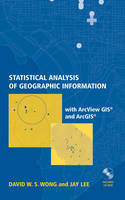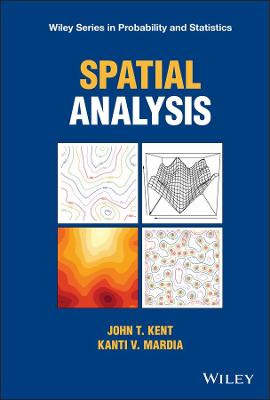Statistical Analysis of Geographic Information with ArcView GIS and ArcGIS
 -15%
portes grátis
-15%
portes grátis
Statistical Analysis of Geographic Information with ArcView GIS and ArcGIS
Lee, Jay; Wong, David W. S.
John Wiley & Sons Inc
11/2005
464
Dura
Inglês
9780471468998
15 a 20 dias
824
Descrição não disponível.
PREFACE. ACKNOWLEDGMENTS.
1 INTRODUCTION.
1.1 Why Statistics and Sampling?
1.2 What Are Special about Spatial Data?
1.3 Spatial Data and the Need for Spatial Analysis/ Statistics.
1.4 Fundamentals of Spatial Analysis and Statistics.
1.5 ArcView Notes-Data Model and Examples.
PART I: CLASSICAL STATISTICS.
2 DISTRIBUTION DESCRIPTORS: ONE VARIABLE (UNIVARIATE).
2.1 Measures of Central Tendency.
2.2 Measures of Dispersion.
2.3 ArcView Examples.
2.4 Higher Moment Statistics.
2.5 ArcView Examples.
2.6 Application Example.
2.7 Summary.
3 RELATIONSHIP DESCRIPTORS: TWO VARIABLES (BIVARIATE).
3.1 Correlation Analysis.
3.2 Correlation: Nominal Scale.
3.3 Correlation: Ordinal Scale.
3.4 Correlation: Interval /Ratio Scale.
3.5 Trend Analysis.
3.6 ArcView Notes.
3.7 Application Examples.
4 HYPOTHESIS TESTERS.
4.1 Probability Concepts.
4.2 Probability Functions.
4.3 Central Limit Theorem and Confidence Intervals.
4.4 Hypothesis Testing.
4.5 Parametric Test Statistics.
4.6 Difference in Means.
4.7 Difference Between a Mean and a Fixed Value.
4.8 Significance of Pearson's Correlation Coefficient.
4.9 Significance of Regression Parameters.
4.10 Testing Nonparametric Statistics.
4.11 Summary.
PART II: SPATIAL STATISTICS.
5 POINT PATTERN DESCRIPTORS.
5.1 The Nature of Point Features.
5.2 Central Tendency of Point Distributions.
5.3 Dispersion and Orientation of Point Distributions.
5.4 ArcView Notes.
5.5 Application Examples.
6 POINT PATTERN ANALYZERS.
6.1 Scale and Extent.
6.2 Quadrat Analysis.
6.3 Ordered Neighbor Analysis.
6.4 K-Function.
6.5 Spatial Autocorrelation of Points.
6.6 Application Examples.
7 LINE PATTERN ANALYZERS.
7.1 The Nature of Linear Features: Vectors and Networks.
7.2 Characteristics and Attributes of Linear Features.
7.3 Directional Statistics.
7.4 Network Analysis.
7.5 Application Examples.
8 POLYGON PATTERN ANALYZERS.
8.1 Introduction.
8.2 Spatial Relationships.
8.3 Spatial Dependency.
8.4 Spatial Weights Matrices.
8.5 Spatial Autocorrelation Statistics and Notations.
8.6 Joint Count Statistics.
8.7 Spatial Autocorrelation Global Statistics.
8.8 Local Spatial Autocorrelation Statistics.
8.9 Moran Scatterplot.
8.10 Bivariate Spatial Autocorrelation.
8.11 Application Examples.
8.12 Summary.
APPENDIX: ArcGIS Spatial Statistics Tools.
ABOUT THE CD-ROM.
INDEX.
1 INTRODUCTION.
1.1 Why Statistics and Sampling?
1.2 What Are Special about Spatial Data?
1.3 Spatial Data and the Need for Spatial Analysis/ Statistics.
1.4 Fundamentals of Spatial Analysis and Statistics.
1.5 ArcView Notes-Data Model and Examples.
PART I: CLASSICAL STATISTICS.
2 DISTRIBUTION DESCRIPTORS: ONE VARIABLE (UNIVARIATE).
2.1 Measures of Central Tendency.
2.2 Measures of Dispersion.
2.3 ArcView Examples.
2.4 Higher Moment Statistics.
2.5 ArcView Examples.
2.6 Application Example.
2.7 Summary.
3 RELATIONSHIP DESCRIPTORS: TWO VARIABLES (BIVARIATE).
3.1 Correlation Analysis.
3.2 Correlation: Nominal Scale.
3.3 Correlation: Ordinal Scale.
3.4 Correlation: Interval /Ratio Scale.
3.5 Trend Analysis.
3.6 ArcView Notes.
3.7 Application Examples.
4 HYPOTHESIS TESTERS.
4.1 Probability Concepts.
4.2 Probability Functions.
4.3 Central Limit Theorem and Confidence Intervals.
4.4 Hypothesis Testing.
4.5 Parametric Test Statistics.
4.6 Difference in Means.
4.7 Difference Between a Mean and a Fixed Value.
4.8 Significance of Pearson's Correlation Coefficient.
4.9 Significance of Regression Parameters.
4.10 Testing Nonparametric Statistics.
4.11 Summary.
PART II: SPATIAL STATISTICS.
5 POINT PATTERN DESCRIPTORS.
5.1 The Nature of Point Features.
5.2 Central Tendency of Point Distributions.
5.3 Dispersion and Orientation of Point Distributions.
5.4 ArcView Notes.
5.5 Application Examples.
6 POINT PATTERN ANALYZERS.
6.1 Scale and Extent.
6.2 Quadrat Analysis.
6.3 Ordered Neighbor Analysis.
6.4 K-Function.
6.5 Spatial Autocorrelation of Points.
6.6 Application Examples.
7 LINE PATTERN ANALYZERS.
7.1 The Nature of Linear Features: Vectors and Networks.
7.2 Characteristics and Attributes of Linear Features.
7.3 Directional Statistics.
7.4 Network Analysis.
7.5 Application Examples.
8 POLYGON PATTERN ANALYZERS.
8.1 Introduction.
8.2 Spatial Relationships.
8.3 Spatial Dependency.
8.4 Spatial Weights Matrices.
8.5 Spatial Autocorrelation Statistics and Notations.
8.6 Joint Count Statistics.
8.7 Spatial Autocorrelation Global Statistics.
8.8 Local Spatial Autocorrelation Statistics.
8.9 Moran Scatterplot.
8.10 Bivariate Spatial Autocorrelation.
8.11 Application Examples.
8.12 Summary.
APPENDIX: ArcGIS Spatial Statistics Tools.
ABOUT THE CD-ROM.
INDEX.
Este título pertence ao(s) assunto(s) indicados(s). Para ver outros títulos clique no assunto desejado.
geography, urban planning, wildlife biology, forestry, natural resource management, geology, GIS
PREFACE. ACKNOWLEDGMENTS.
1 INTRODUCTION.
1.1 Why Statistics and Sampling?
1.2 What Are Special about Spatial Data?
1.3 Spatial Data and the Need for Spatial Analysis/ Statistics.
1.4 Fundamentals of Spatial Analysis and Statistics.
1.5 ArcView Notes-Data Model and Examples.
PART I: CLASSICAL STATISTICS.
2 DISTRIBUTION DESCRIPTORS: ONE VARIABLE (UNIVARIATE).
2.1 Measures of Central Tendency.
2.2 Measures of Dispersion.
2.3 ArcView Examples.
2.4 Higher Moment Statistics.
2.5 ArcView Examples.
2.6 Application Example.
2.7 Summary.
3 RELATIONSHIP DESCRIPTORS: TWO VARIABLES (BIVARIATE).
3.1 Correlation Analysis.
3.2 Correlation: Nominal Scale.
3.3 Correlation: Ordinal Scale.
3.4 Correlation: Interval /Ratio Scale.
3.5 Trend Analysis.
3.6 ArcView Notes.
3.7 Application Examples.
4 HYPOTHESIS TESTERS.
4.1 Probability Concepts.
4.2 Probability Functions.
4.3 Central Limit Theorem and Confidence Intervals.
4.4 Hypothesis Testing.
4.5 Parametric Test Statistics.
4.6 Difference in Means.
4.7 Difference Between a Mean and a Fixed Value.
4.8 Significance of Pearson's Correlation Coefficient.
4.9 Significance of Regression Parameters.
4.10 Testing Nonparametric Statistics.
4.11 Summary.
PART II: SPATIAL STATISTICS.
5 POINT PATTERN DESCRIPTORS.
5.1 The Nature of Point Features.
5.2 Central Tendency of Point Distributions.
5.3 Dispersion and Orientation of Point Distributions.
5.4 ArcView Notes.
5.5 Application Examples.
6 POINT PATTERN ANALYZERS.
6.1 Scale and Extent.
6.2 Quadrat Analysis.
6.3 Ordered Neighbor Analysis.
6.4 K-Function.
6.5 Spatial Autocorrelation of Points.
6.6 Application Examples.
7 LINE PATTERN ANALYZERS.
7.1 The Nature of Linear Features: Vectors and Networks.
7.2 Characteristics and Attributes of Linear Features.
7.3 Directional Statistics.
7.4 Network Analysis.
7.5 Application Examples.
8 POLYGON PATTERN ANALYZERS.
8.1 Introduction.
8.2 Spatial Relationships.
8.3 Spatial Dependency.
8.4 Spatial Weights Matrices.
8.5 Spatial Autocorrelation Statistics and Notations.
8.6 Joint Count Statistics.
8.7 Spatial Autocorrelation Global Statistics.
8.8 Local Spatial Autocorrelation Statistics.
8.9 Moran Scatterplot.
8.10 Bivariate Spatial Autocorrelation.
8.11 Application Examples.
8.12 Summary.
APPENDIX: ArcGIS Spatial Statistics Tools.
ABOUT THE CD-ROM.
INDEX.
1 INTRODUCTION.
1.1 Why Statistics and Sampling?
1.2 What Are Special about Spatial Data?
1.3 Spatial Data and the Need for Spatial Analysis/ Statistics.
1.4 Fundamentals of Spatial Analysis and Statistics.
1.5 ArcView Notes-Data Model and Examples.
PART I: CLASSICAL STATISTICS.
2 DISTRIBUTION DESCRIPTORS: ONE VARIABLE (UNIVARIATE).
2.1 Measures of Central Tendency.
2.2 Measures of Dispersion.
2.3 ArcView Examples.
2.4 Higher Moment Statistics.
2.5 ArcView Examples.
2.6 Application Example.
2.7 Summary.
3 RELATIONSHIP DESCRIPTORS: TWO VARIABLES (BIVARIATE).
3.1 Correlation Analysis.
3.2 Correlation: Nominal Scale.
3.3 Correlation: Ordinal Scale.
3.4 Correlation: Interval /Ratio Scale.
3.5 Trend Analysis.
3.6 ArcView Notes.
3.7 Application Examples.
4 HYPOTHESIS TESTERS.
4.1 Probability Concepts.
4.2 Probability Functions.
4.3 Central Limit Theorem and Confidence Intervals.
4.4 Hypothesis Testing.
4.5 Parametric Test Statistics.
4.6 Difference in Means.
4.7 Difference Between a Mean and a Fixed Value.
4.8 Significance of Pearson's Correlation Coefficient.
4.9 Significance of Regression Parameters.
4.10 Testing Nonparametric Statistics.
4.11 Summary.
PART II: SPATIAL STATISTICS.
5 POINT PATTERN DESCRIPTORS.
5.1 The Nature of Point Features.
5.2 Central Tendency of Point Distributions.
5.3 Dispersion and Orientation of Point Distributions.
5.4 ArcView Notes.
5.5 Application Examples.
6 POINT PATTERN ANALYZERS.
6.1 Scale and Extent.
6.2 Quadrat Analysis.
6.3 Ordered Neighbor Analysis.
6.4 K-Function.
6.5 Spatial Autocorrelation of Points.
6.6 Application Examples.
7 LINE PATTERN ANALYZERS.
7.1 The Nature of Linear Features: Vectors and Networks.
7.2 Characteristics and Attributes of Linear Features.
7.3 Directional Statistics.
7.4 Network Analysis.
7.5 Application Examples.
8 POLYGON PATTERN ANALYZERS.
8.1 Introduction.
8.2 Spatial Relationships.
8.3 Spatial Dependency.
8.4 Spatial Weights Matrices.
8.5 Spatial Autocorrelation Statistics and Notations.
8.6 Joint Count Statistics.
8.7 Spatial Autocorrelation Global Statistics.
8.8 Local Spatial Autocorrelation Statistics.
8.9 Moran Scatterplot.
8.10 Bivariate Spatial Autocorrelation.
8.11 Application Examples.
8.12 Summary.
APPENDIX: ArcGIS Spatial Statistics Tools.
ABOUT THE CD-ROM.
INDEX.
Este título pertence ao(s) assunto(s) indicados(s). Para ver outros títulos clique no assunto desejado.






